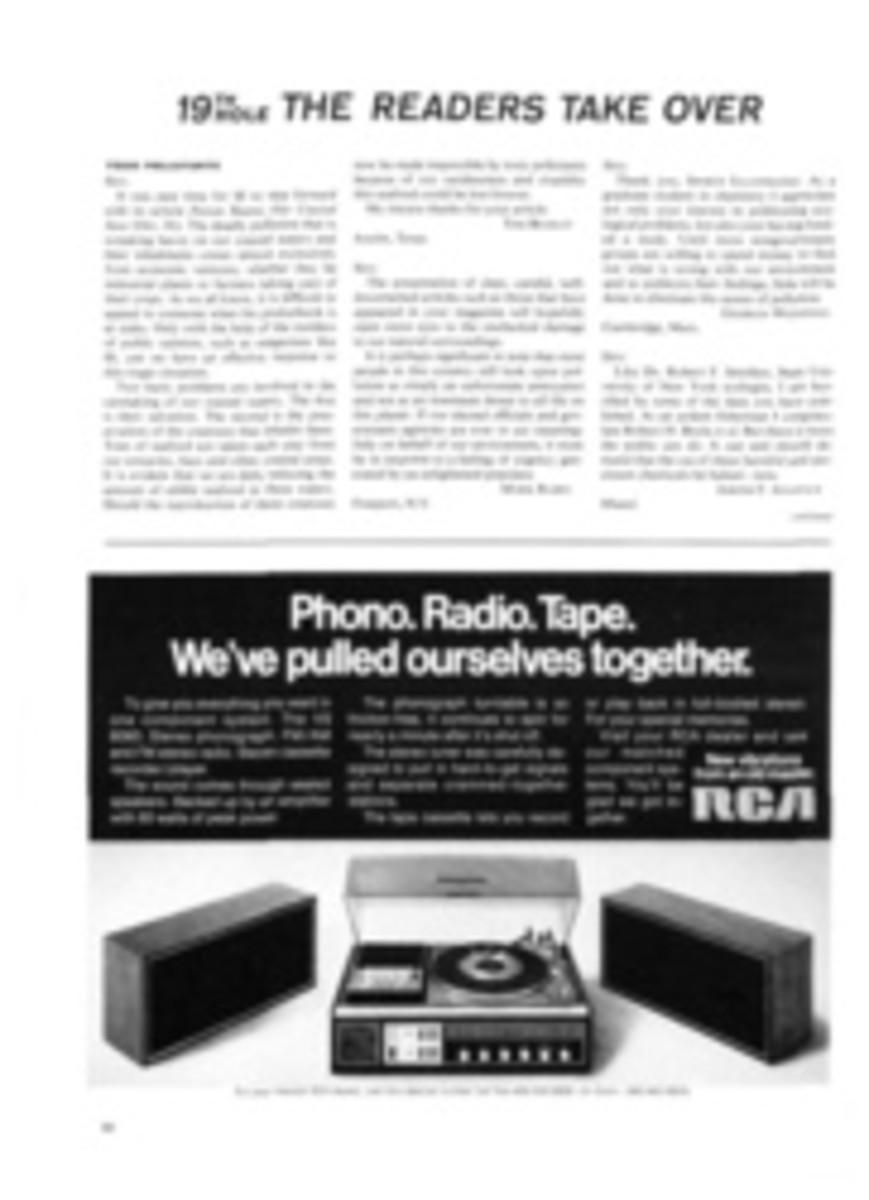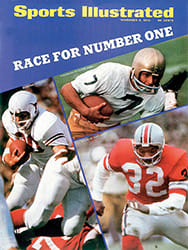
The run was a natural gas
There was a time when Gary Gabelich seemed headed for the moon. He qualified for a program involving astronaut training and worked hard at it. He ran six miles every other day, and he frequently fell out of the sky with a movie camera, photographing the actions of parachutes opening. He lived in earthbound space capsules for days at a time under simulated high-altitude conditions. He grew wiry, with 155 pounds of lean muscle over his 6-foot frame. But he dropped out of the program when it became clear that he would not be permitted to pilot the spaceship up there and back. If Gary does not get to drive a thing, he doesn't want to go.
That was in 1968. In the months that followed, Gabelich sort of careened around. He kept on sky diving. He played tennis, baseball, handball, raced gokarts, went surfing and water skiing. Mostly, he turned to motor sports. He raced cars, motorcycles, fuel and jet dragsters, even drag boats. By 1968 he was the American Power Boat Association fuel-hydro champ. Then, last September, he hit 200.44 mph in a drag boat, fastest such run ever recorded. All of which, in the inexorable manner of such things, finally brought him, at 30 years of age, to the Bonneville Salt Flats and this monster jet car called Blue Flame.
Racing cars is one thing. But driving a vehicle faster than anybody in the world is the ultimate, the nub of it all, the final stinging glory of speed. By the time Gabelich got to the rocket car on the desert, the world land-speed record was a tidy 600.601 mph, a mark set in 1965 by Craig Breedlove.
Gabelich has changed since his pre-astronaut days, in the subtle ways that would better prepare him for his run across the salt. No more conservative clothes, no NASA haircut. He is a lot more hip, with deliberately shaggy hair that tumbles almost to his shoulders. More Captain America than Captain Carpenter. His talk now is studded with phrases calculated to indicate he is very with-it, and he is apt to refer to something as being "plenty boss," which really means it is a bit of all right. Upon checking in at the tiny border town of Wendover on Sept. 14, the Gabelich crew put a lot of champagne on ice. They would drink it when he broke the world speed record. A plenty boss gesture. And then they learned that it is not that easy: it was to be 39 days before they got to taste the wine.
First, there was that fearsome super-car that dominated everything around it on the desert—38.2 feet from nose to tail, 8.8 feet to the top of its tailfin, 7.8 feet wide. It weighed 6,500 pounds. The rear tires were 35 inches high, about as tall as, say, Mario Andretti. "It is, basically, a long piece of pipe," said Gabelich. "It is built to run horizontally, man, not vertically."
Laid over it all was a snappy silver and blue paint job, and fitted inside the pipe was a 770-pound rocket engine tuned to 16,000 pounds of thrust—which figures out to 58,000 horsepower. The Blue Flame, Gabelich found, could accelerate from zero to 650 mph in 20 seconds. The cockpit was basic: the steering system and throttle, cameras, a recorder and radio setup over which Gabelich would talk to his crew. Not hip conversation.
"I would flick on all the switches and shout 'here we go!' " he says. "Then I would slam it right to the wood and count off my speed: 250...300...350...400. Man, it's really far out."
Before selecting Gabelich to drive the Blue Flame, a great many experts had a hand in the project. Prime sponsor was the Natural Gas Industry, which is a combine of 52 companies in gas and related fields—the sort of staid, vest-wearing outfits hardly ever associated with such madcap adventure. Still, it seemed a dramatic way to demonstrate what they feel is the safety and versatility of natural gas as a pure form of pollution-free power. The liquefied natural gas-hydrogen peroxide concept for the engine came from an astronautish-sounding Milwaukee outfit called Reaction Dynamics Inc. Goodyear, which has a long association with land-speed attempts, developed the tires over a year of research, rolled them out to Bonneville and pronounced them capable of speeds up to 700 mph and tested in excess of 800, if Gabelich cared to go that fast.
Not at first. The Utah flats are tricky: a vast bed of crystalline with mountains on one side, more mountains on the other, a 10-mile black guideline painted straight across—and unpredictable weather in between. The salt tends to be uneven in texture; the winds blow capriciously—headwinds, crosswinds, the works. And anything over the gentle push of a 6-mph breeze can scratch a run. Gabelich did not get in his first attempt until Sept. 19. Then, in 19 more attacks, he got the monster up over 600 mph seven times, and twice just barely missed the two-way record.
According to the worldwide rules that govern such things, a land-speed mark is recognized only after two runs through the flying kilometer and measured mile clocks. Both runs must be made within one hour and, for all their early speed down the black line, the crew approached the record slowly. Finally came the morning of Friday, Oct. 23 when, as Gabelich puts it, "They got it all together."
For the record, let it be noted that the fastest man in the world fueled up on hot chocolate, cereal and a cinnamon roll, accompanied by the digestion-inducing sounds of Creedence Clearwater Revival on the cafe jukebox. He was wearing his lucky canary-colored T shirt, Levi's and black stocking cap. On top of that, at the Flats, he added the things he wanted for spiritual comfort: 28 strands of beads around his neck, a hair clip from his girlfriend, a St. Christopher medal, various Indian good-luck pieces, a Mexican peso, several key chains and four letters which had been carried by John Cobb during his 1947 record run in which he averaged 394.196 mph.
Spirit thus fortified, Gabelich took care of the physical: over all that stuff he donned flame-resistant suit, gloves, boots, face mask and helmet—producing an effect that was pretty much astronaut at that. Except that the suit also displays the decals of the participating companies, plus one peace symbol and one American flag. That left only one thing left to do: talk to the car. Gabelich patted the nose cone and said to the Blue Flame, urgently: "Let's do it together, baby. Give me a good ride. Let's go, baby. You can do it. We can do it together, baby." Then he climbed into the cockpit.
"This is what happens," says Gabelich. "You're sitting in it and they put the cover on you. Suddenly, all my adrenaline pumps up to about the same pressure as the gas. My thinking clears up and it's all beautiful. I'm in a completely different world, man. I know how a lion tamer feels. I turn on the recordings and let it go: suddenly I'm blasted back into the seat and my body conforms to it exactly. And I count off the speeds. Then my hearing cuts out at 600 mph and it's all beautifully still, quiet. It's better than sex, man, it's better than anything."
First run down, the Blue Flame hit 617.602 mph through the measured mile. In 48½ minutes the car was ready for the run back. The truck eased up behind and started the push-off. It got the Blue Flame rolling down the approach at about 35 mph and backed off. Inside the cockpit, Gabelich fired off the engine with a shattering roar and was away.
The slick tires quickly picked up a coating of damp salt, creating the eerie visual effect that the car was floating, slightly airborne, as it flashed through the mile, stretched out in a long, shimmering silver-blue streak. Behind it, drifting lazily, came puffs of fluffy white vapor. And inside the cockpit, despite the push of some five G's, Gabelich kept his cool. "It was smooth, very smooth," he said. "It seemed to float a little. Nothing wrong, though. Everything was perfect." Then, even as the car zinged past the timing trailer, the chutes puffed out and it was all over: 630.388 mph through the kilo and 627.287 mph through the mile. A world record two-way average of 622.407 mph.
When the crew unsnapped the canopy and unstrapped him, Gabelich, now officially the fastest man in the world, uttered the historic words: "Plenty boss, man, plenty boss." Then he added, more prosaically, "I knew it was a good one. It was a wild ride. We really got with it. I'm very happy.
"Next year," said Gabelich, "we'll go after the speed of sound. It's about 720 miles an hour at this altitude. I'm also looking for a sponsor to build me a rocket-powered boat. I want to be the first man to hold both land-and water-speed records and survive."
Then they all piled into cars and paraded back to Wendover, honking horns and shouting the news. And they finally drank the champagne. Plenty boss. Maybe better than going to the moon.
PHOTO
OFFICIALLY THE FASTEST: GABELICH
PHOTO

